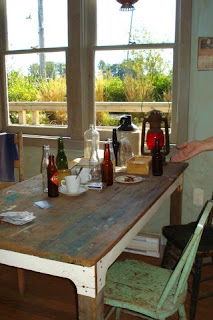Steveston Village, located on the southwestern shore of Richmond, was once a frontier seaport and principal port on the mighty Fraser River. It was founded by William Herbert Steves in 1880. He imagined it would be a town that would rival Vancouver. The town flourished up to 1910 and then there was a decline in the salmon industry. At the turn of the twentieth century the village was one of the busiest fishing ports in the world. There were fifteen salmon canneries, six hotels, numerous saloons and gambling dens and daily windjammers anchored in the port loading canned salmon to distribute to the world markets. On weekends, up to 10,000 people thronged Steveston's boardwalks: sailors from all over the world, Native Indians, Japanese, Chinese and European immigrants. In 1918 a devastating fire destroyed much of the town and there was more hardship during the 1930`s depression.
Bunkhouse kitchen
At the time the Second World War broke out there were many Japanese fishermen living here and after Pearl Harbour their boats and property were seized as they were all sent away to interment and Steveston lost half its population and many businesses. There is a small memorial park for the Japanese fishermen at Garry Point and one of the historic houses left at Steveston belonged to a Japanese family.
It's always a pleasant outing to spend the day at Steveston. You can rent bikes to ride along the dikes, visit the fish market on the wharf, or the Farmer's Market. Or just stroll along the boardwalk and take in all the sights while you investigate the heritage buildings, some now turned into museums.
Kite flying at Garry Point
Last weekend my friends and went to Steveston, first for a salmon barbecue at my friend Diane's home. She bought the fish fresh from the fish market on Steveston's wharf. Then we set off for a tour, to show my friend from Germany around. Patrick has been to Vancouver many times, but never to Steveston.By the Steveston boat works
We started off at one end of the boardwalk where there are several heritage houses including one of the bunkhouses used for workers in the cannery. The day was hot and so walking along by the river was refreshing. When we got to Steveston town there are many boutiques and excellent dock-side restaurants: everything from seafood to Italian food. One of the most popular (on the wharf) is Pajo`s Fish and Chips. The town itself has many heritage buildings including the Steveston Museum which shows the history of the community. (pick up a brochure that will guide you through a Steveston Village Heritage Walking tour).
Fisherman`s Wharf
The Fisherman`s Wharf was bustling with activity as the fish boats were in port displaying their catch and lots of people go there to buy their fresh salmon, shell fish and even sea urchins. Sea Urchins
Fresh Salmon for Sale
Sculpture of Salmon Cannery Workers.
The day proved to be invigorating and somewhat tiring by the time we walked all the way back to where the car was parked. But if you take the bus there, or drive, you can park in the village and walk from there. I also recommend renting bikes down on the wharf and cycling the dikes. If you cycle east you`ll reach the historic London Heritage Farm or going around Garry Point you can cycle as far as the airport.
Fishermen`s Memorial at Garry Point
Patrick and I with a view of the River from Garry Point















No comments:
Post a Comment